engine FIAT QUBO 2010 1.G Workshop Manual
[x] Cancel search | Manufacturer: FIAT, Model Year: 2010, Model line: QUBO, Model: FIAT QUBO 2010 1.GPages: 230, PDF Size: 4.38 MB
Page 170 of 230

Thousands of kilometres 30 60 90 120 150 180
Top up fluid levels (engine coolant, brake fluid, battery, wind-
screen washer, etc.)●●●●●●
Check engine control system operation (through diagnostic inter-
face)●●●●●●
Check mechanical gearbox fluid●●
Check cleanliness of sliding side door lower guides (or every 6
months)●●●●●●
Change engine oil and replace oil filter (or every 24 months)●●●●●●
Change brake fluid (or every 24 months)●●●
Change pollen filter (or 12 months)●●●●●●
Change engine oil and filter every 12 months if the vehicle is driven mainly in towns.
169
KNOW YOUR
VEHICLE
SAFETY
STARTING AND
DRIVING
WARNING LIGHTS
AND MESSAGES
IN AN EMERGENCY
SERVICING AND
MAINTENANCE
TECHNICAL
SPECIFICA
TIONS
INDEX
Page 171 of 230
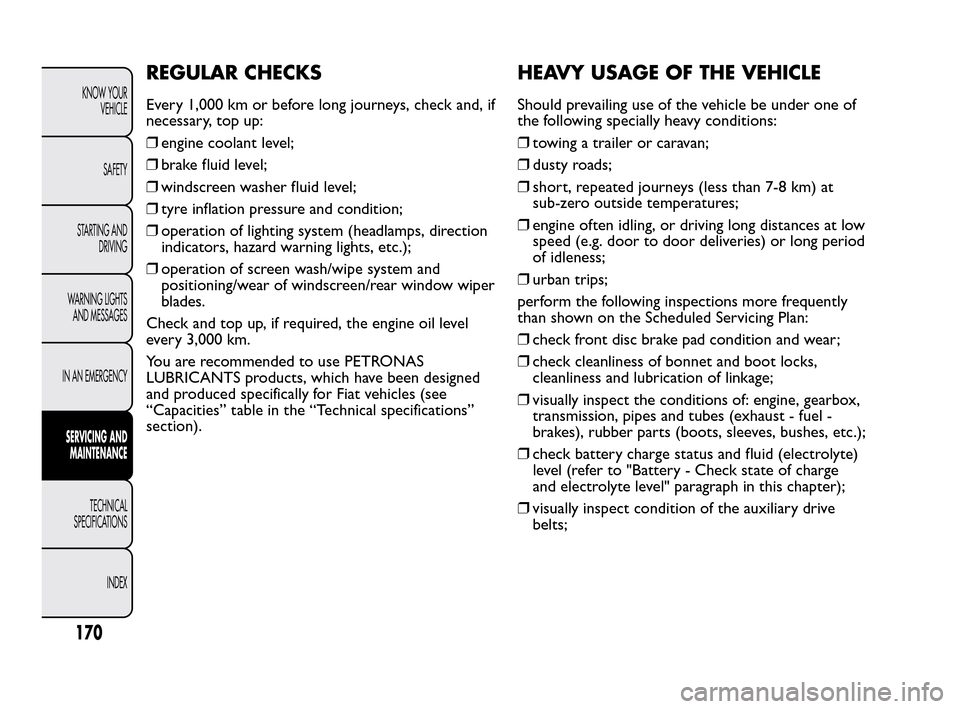
REGULAR CHECKS
Every 1,000 km or before long journeys, check and, if
necessary, top up:
❒engine coolant level;
❒brake fluid level;
❒windscreen washer fluid level;
❒tyre inflation pressure and condition;
❒operation of lighting system (headlamps, direction
indicators, hazard warning lights, etc.);
❒operation of screen wash/wipe system and
positioning/wear of windscreen/rear window wiper
blades.
Check and top up, if required, the engine oil level
every 3,000 km.
You are recommended to use PETRONAS
LUBRICANTS products, which have been designed
and produced specifically for Fiat vehicles (see
“Capacities” table in the “Technical specifications”
section).
HEAVY USAGE OF THE VEHICLE
Should prevailing use of the vehicle be under one of
the following specially heavy conditions:
❒towing a trailer or caravan;
❒dusty roads;
❒short, repeated journeys (less than 7-8 km) at
sub-zero outside temperatures;
❒engine often idling, or driving long distances at low
speed (e.g. door to door deliveries) or long period
of idleness;
❒urban trips;
perform the following inspections more frequently
than shown on the Scheduled Servicing Plan:
❒check front disc brake pad condition and wear;
❒check cleanliness of bonnet and boot locks,
cleanliness and lubrication of linkage;
❒visually inspect the conditions of: engine, gearbox,
transmission, pipes and tubes (exhaust - fuel -
brakes), rubber parts (boots, sleeves, bushes, etc.);
❒check battery charge status and fluid (electrolyte)
level (refer to "Battery - Check state of charge
and electrolyte level" paragraph in this chapter);
❒visually inspect condition of the auxiliary drive
belts;
170
KNOW YOUR
VEHICLE
SAFETY
STARTING AND
DRIVING
WARNING LIGHTS
AND MESSAGES
IN AN EMERGENCY
SERVICING AND
MAINTENANCE
TECHNICAL
SPECIFICA
TIONS
INDEX
Page 173 of 230
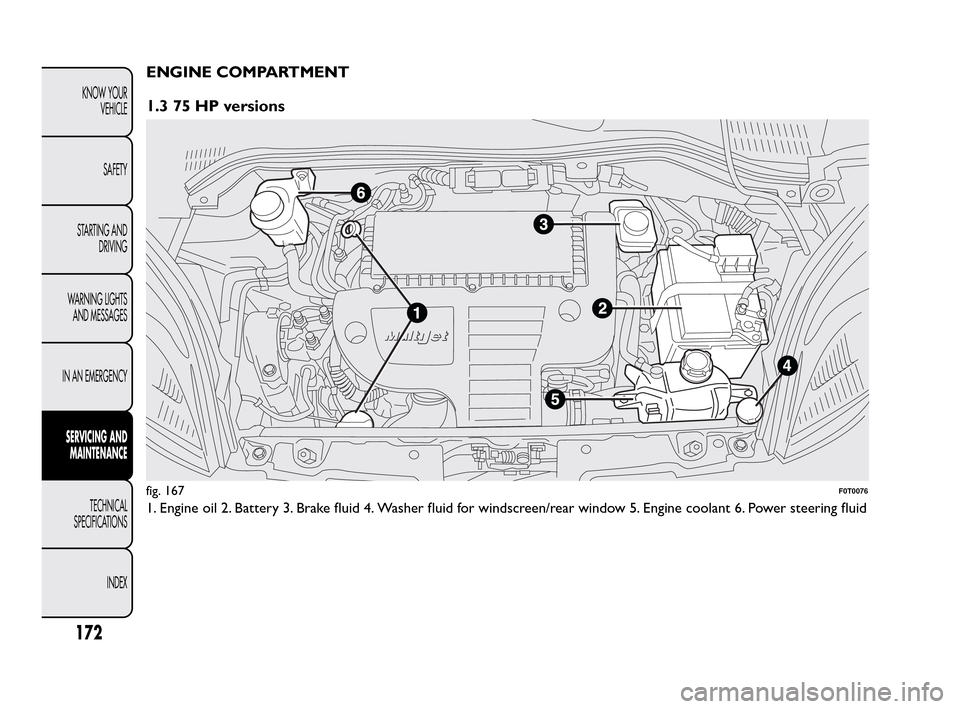
ENGINE COMPARTMENT
1.3 75 HP versions
1. Engine oil 2. Battery 3. Brake fluid 4. Washer fluid for windscreen/rear window 5. Engine coolant 6. Power steering fluid
fig. 167F0T0076
172
KNOW YOUR
VEHICLE
SAFETY
STARTING AND
DRIVING
WARNING LIGHTS
AND MESSAGES
IN AN EMERGENCY
SERVICING AND
MAINTENANCE
TECHNICAL
SPECIFICA
TIONS
INDEX
Page 174 of 230
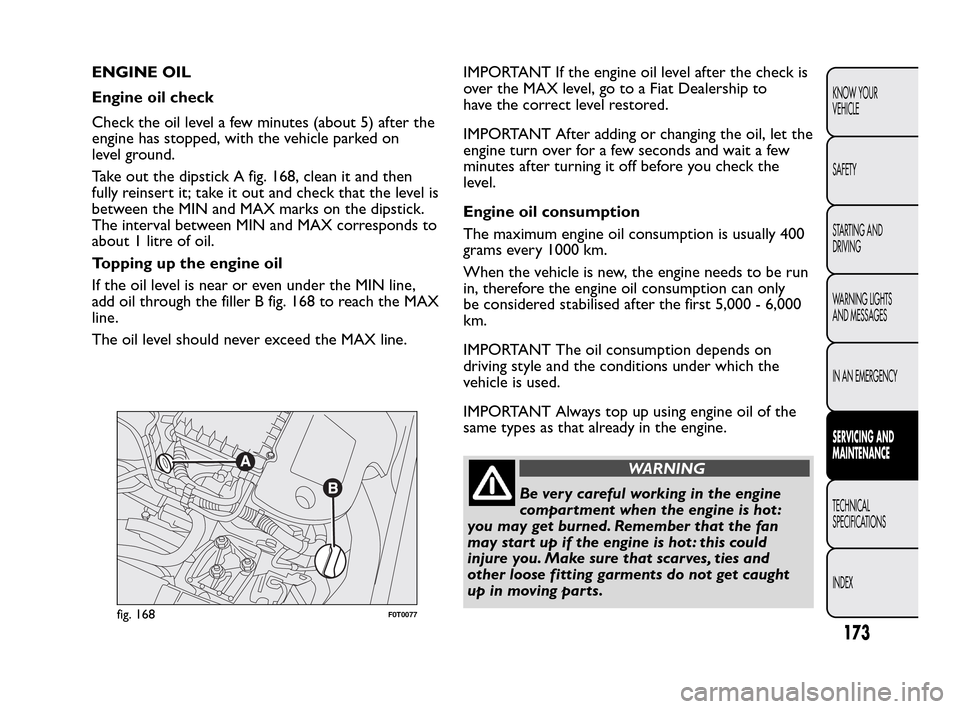
ENGINE OIL
Engine oil check
Check the oil level a few minutes (about 5) after the
engine has stopped, with the vehicle parked on
level ground.
Take out the dipstick A fig. 168, clean it and then
fully reinsert it; take it out and check that the level is
between the MIN and MAX marks on the dipstick.
The interval between MIN and MAX corresponds to
about 1 litre of oil.
Topping up the engine oil
If the oil level is near or even under the MIN line,
add oil through the filler B fig. 168 to reach the MAX
line.
The oil level should never exceed the MAX line.IMPORTANT If the engine oil level after the check is
over the MAX level, go to a Fiat Dealership to
have the correct level restored.
IMPORTANT After adding or changing the oil, let the
engine turn over for a few seconds and wait a few
minutes after turning it off before you check the
level.
Engine oil consumption
The maximum engine oil consumption is usually 400
grams every 1000 km.
When the vehicle is new, the engine needs to be run
in, therefore the engine oil consumption can only
be considered stabilised after the first 5,000 - 6,000
km.
IMPORTANT The oil consumption depends on
driving style and the conditions under which the
vehicle is used.
IMPORTANT Always top up using engine oil of the
same types as that already in the engine.
WARNING
Be very careful working in the engine
c
ompartment when the engine is hot :
you may get burned. Remember that the fan
may start up if the engine is hot : this could
injure you. Make sure that scarves, ties and
other loose fitting garments do not get caught
up in moving parts.
fig. 168F0T0077
173
KNOW YOUR
VEHICLE
SAFETY
STARTING AND
DRIVING
WARNING LIGHTS
AND MESSAGES
IN AN EMERGENCY
SERVICING AND
MAINTENANCE
TECHNICAL
SPECIFICA
TIONS
INDEX
Page 175 of 230
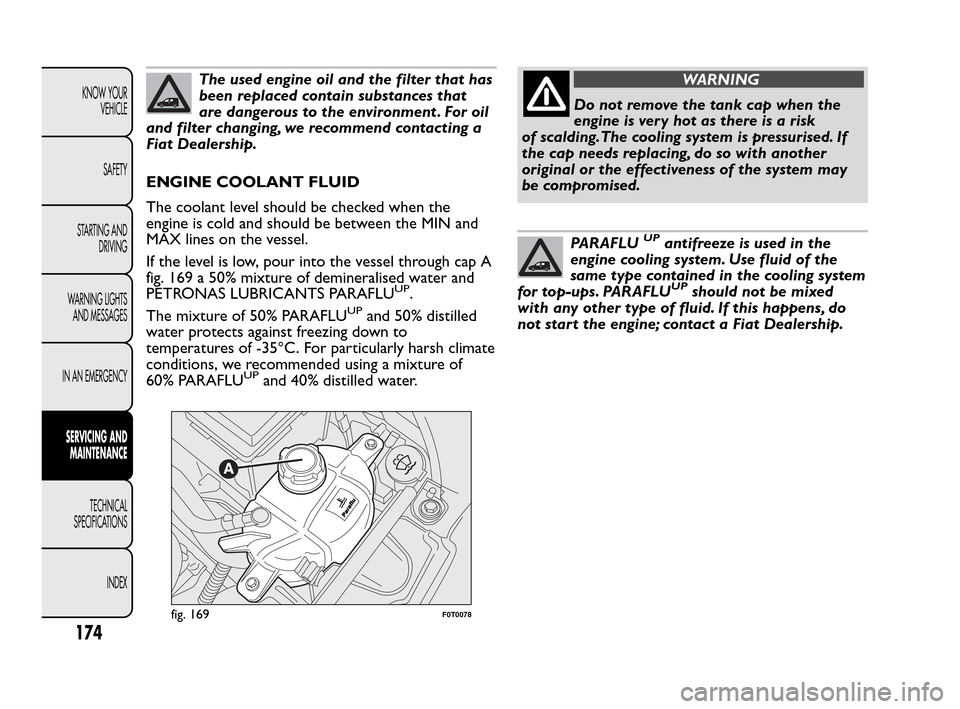
The used engine oil and the filter that has
been replaced contain substances that
are dangerous to the environment . For oil
and filter changing, we recommend contacting a
Fiat Dealership.
ENGINE COOLANT FLUID
The coolant level should be checked when the
engine is cold and should be between the MIN and
MAX lines on the vessel.
If the level is low, pour into the vessel through cap A
fig. 169 a 50% mixture of demineralised water and
PETRONAS LUBRICANTS PARAFLU
UP.
The mixture of 50% PARAFLU
UPand 50% distilled
water protects against freezing down to
temperatures of -35°C. For particularly harsh climate
conditions, we recommended using a mixture of
60% PARAFLU
UPand 40% distilled water.
WARNING
Do not remove the tank cap when the
en
gine is very hot as there is a risk
of scalding.The cooling system is pressurised. If
the cap needs replacing, do so with another
original or the effectiveness of the system may
be compromised.
PARAFLUUPantifreeze is used in the
engine cooling system. Use fluid of the
same type contained in the cooling system
for top-ups. PARAFLU
UPshould not be mixed
with any other type of fluid. If this happens, do
not start the engine; contact a Fiat Dealership.
fig. 169F0T0078
174
KNOW YOUR
VEHICLE
SAFETY
STARTING AND
DRIVING
WARNING LIGHTS
AND MESSAGES
IN AN EMERGENCY
SERVICING AND
MAINTENANCE
TECHNICAL
SPECIFICA
TIONS
INDEX
Page 176 of 230
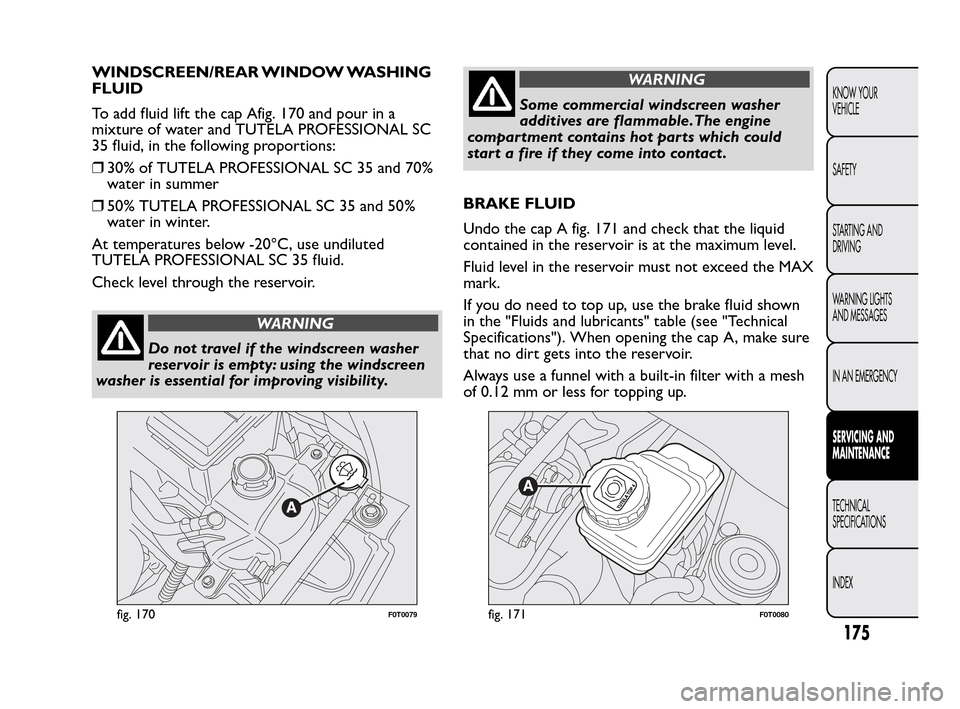
WINDSCREEN/REAR WINDOW WASHING
FLUID
To add fluid lift the cap Afig. 170 and pour in a
mixture of water and TUTELA PROFESSIONAL SC
35 fluid, in the following proportions:
❒30% of TUTELA PROFESSIONAL SC 35 and 70%
water in summer
❒50% TUTELA PROFESSIONAL SC 35 and 50%
water in winter.
At temperatures below -20°C, use undiluted
TUTELA PROFESSIONAL SC 35 fluid.
Check level through the reservoir.
WARNING
Do not travel if the windscreen washer
reser
voir is empty: using the windscreen
washer is essential for improving visibility.
WARNING
Some commercial windscreen washer
addi
tives are flammable.The engine
compartment contains hot parts which could
start a fire if they come into contact .
BRAKE FLUID
Undo the cap A fig. 171 and check that the liquid
contained in the reservoir is at the maximum level.
Fluid level in the reservoir must not exceed the MAX
mark.
If you do need to top up, use the brake fluid shown
in the "Fluids and lubricants" table (see "Technical
Specifications"). When opening the cap A, make sure
that no dirt gets into the reservoir.
Always use a funnel with a built-in filter with a mesh
of 0.12 mm or less for topping up.
fig. 170F0T0079fig. 171F0T0080
175
KNOW YOUR
VEHICLE
SAFETY
STARTING AND
DRIVING
WARNING LIGHTS
AND MESSAGES
IN AN EMERGENCY
SERVICING AND
MAINTENANCE
TECHNICAL
SPECIFICA
TIONS
INDEX
Page 177 of 230
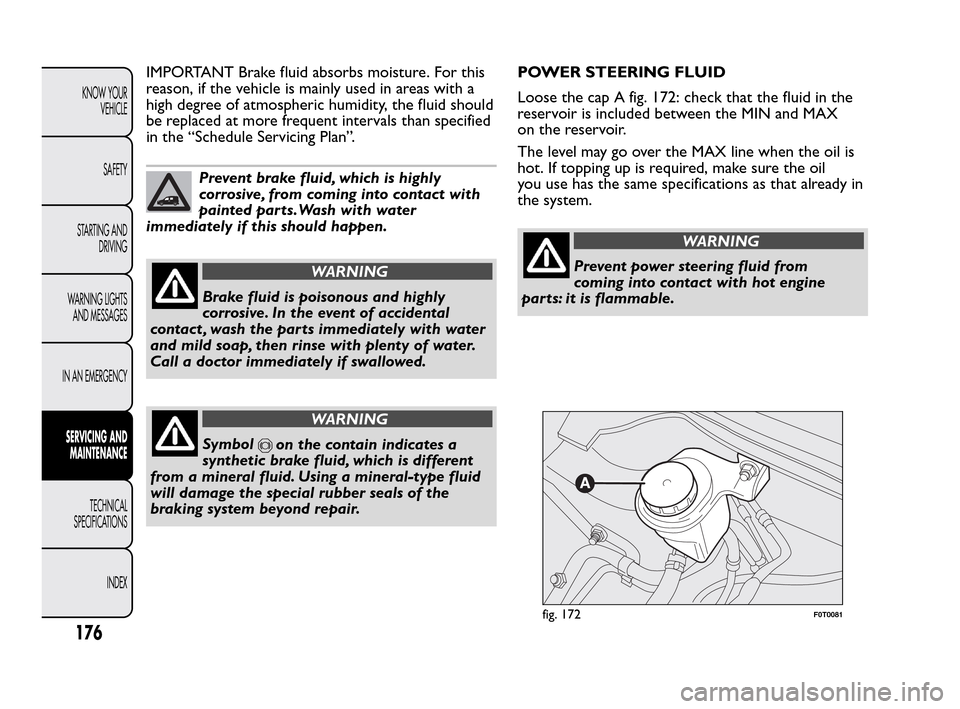
IMPORTANT Brake fluid absorbs moisture. For this
reason, if the vehicle is mainly used in areas with a
high degree of atmospheric humidity, the fluid should
be replaced at more frequent intervals than specified
in the “Schedule Servicing Plan”.
Prevent brake fluid, which is highly
corrosive, from coming into contact with
painted parts.Wash with water
immediately if this should happen.
WARNING
Brake fluid is poisonous and highly
c
orrosive. In the event of accidental
contact , wash the parts immediately with water
and mild soap, then rinse with plenty of water.
Call a doctor immediately if swallowed.
WARNING
Symbolon the contain indicates a
synthetic brake fluid, which is different
from a mineral fluid. Using a mineral-type fluid
will damage the special rubber seals of the
braking system beyond repair.POWER STEERING FLUID
Loose the cap A fig. 172: check that the fluid in the
reservoir is included between the MIN and MAX
on the reservoir.
The level may go over the MAX line when the oil is
hot. If topping up is required, make sure the oil
you use has the same specifications as that already in
the system.
WARNING
Prevent power steering fluid from
c
oming into contact with hot engine
parts: it is flammable.
fig. 172F0T0081
176
KNOW YOUR
VEHICLE
SAFETY
STARTING AND
DRIVING
WARNING LIGHTS
AND MESSAGES
IN AN EMERGENCY
SERVICING AND
MAINTENANCE
TECHNICAL
SPECIFICA
TIONS
INDEX
Page 180 of 230
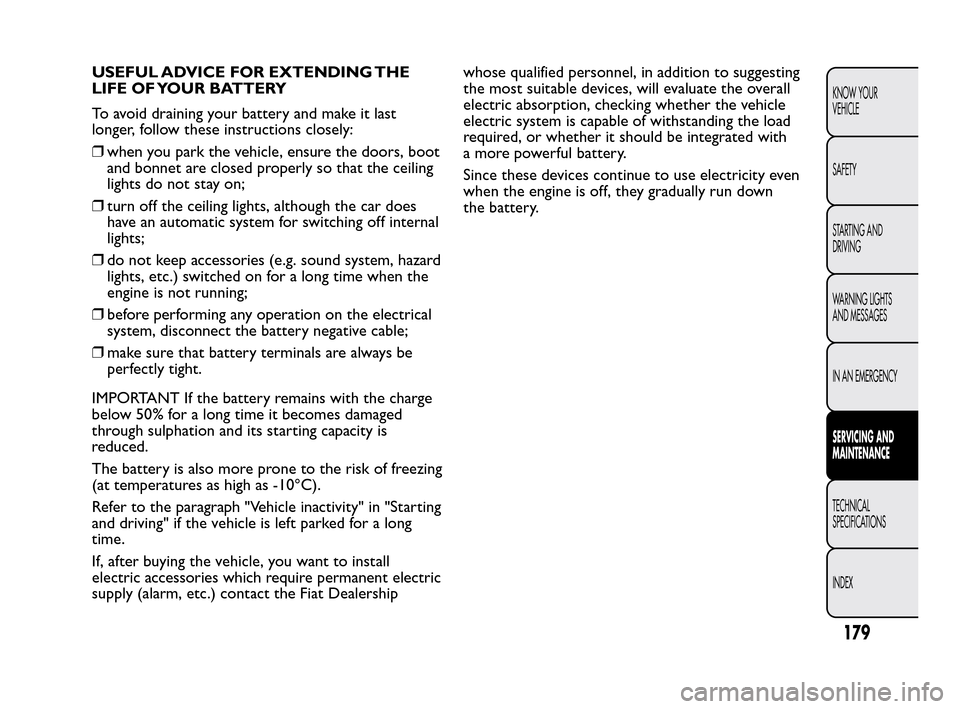
USEFUL ADVICE FOR EXTENDING THE
LIFE OF YOUR BATTERY
To avoid draining your battery and make it last
longer, follow these instructions closely:
❒when you park the vehicle, ensure the doors, boot
and bonnet are closed properly so that the ceiling
lights do not stay on;
❒turn off the ceiling lights, although the car does
have an automatic system for switching off internal
lights;
❒do not keep accessories (e.g. sound system, hazard
lights, etc.) switched on for a long time when the
engine is not running;
❒before performing any operation on the electrical
system, disconnect the battery negative cable;
❒make sure that battery terminals are always be
perfectly tight.
IMPORTANT If the battery remains with the charge
below 50% for a long time it becomes damaged
through sulphation and its starting capacity is
reduced.
The battery is also more prone to the risk of freezing
(at temperatures as high as -10°C).
Refer to the paragraph "Vehicle inactivity" in "Starting
and driving" if the vehicle is left parked for a long
time.
If, after buying the vehicle, you want to install
electric accessories which require permanent electric
supply (alarm, etc.) contact the Fiat Dealershipwhose qualified personnel, in addition to suggesting
the most suitable devices, will evaluate the overall
electric absorption, checking whether the vehicle
electric system is capable of withstanding the load
required, or whether it should be integrated with
a more powerful battery.
Since these devices continue to use electricity even
when the engine is off, they gradually run down
the battery.
179
KNOW YOUR
VEHICLE
SAFETY
STARTING AND
DRIVING
WARNING LIGHTS
AND MESSAGES
IN AN EMERGENCY
SERVICING AND
MAINTENANCE
TECHNICAL
SPECIFICA
TIONS
INDEX
Page 185 of 230
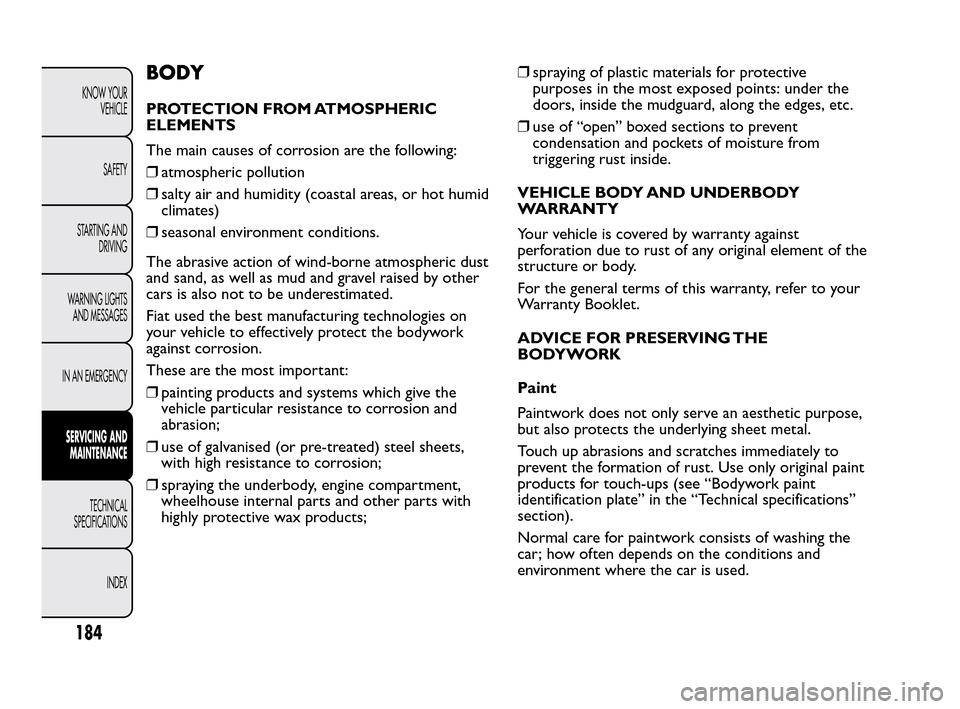
BODY
PROTECTION FROM ATMOSPHERIC
ELEMENTS
The main causes of corrosion are the following:
❒atmospheric pollution
❒salty air and humidity (coastal areas, or hot humid
climates)
❒seasonal environment conditions.
The abrasive action of wind-borne atmospheric dust
and sand, as well as mud and gravel raised by other
cars is also not to be underestimated.
Fiat used the best manufacturing technologies on
your vehicle to effectively protect the bodywork
against corrosion.
These are the most important:
❒painting products and systems which give the
vehicle particular resistance to corrosion and
abrasion;
❒use of galvanised (or pre-treated) steel sheets,
with high resistance to corrosion;
❒spraying the underbody, engine compartment,
wheelhouse internal parts and other parts with
highly protective wax products;❒spraying of plastic materials for protective
purposes in the most exposed points: under the
doors, inside the mudguard, along the edges, etc.
❒use of “open” boxed sections to prevent
condensation and pockets of moisture from
triggering rust inside.
VEHICLE BODY AND UNDERBODY
WARRANTY
Your vehicle is covered by warranty against
perforation due to rust of any original element of the
structure or body.
For the general terms of this warranty, refer to your
Warranty Booklet.
ADVICE FOR PRESERVING THE
BODYWORK
Paint
Paintwork does not only serve an aesthetic purpose,
but also protects the underlying sheet metal.
Touch up abrasions and scratches immediately to
prevent the formation of rust. Use only original paint
products for touch-ups (see “Bodywork paint
identification plate” in the “Technical specifications”
section).
Normal care for paintwork consists of washing the
car; how often depends on the conditions and
environment where the car is used.
184
KNOW YOUR
VEHICLE
SAFETY
STARTING AND
DRIVING
WARNING LIGHTS
AND MESSAGES
IN AN EMERGENCY
SERVICING AND
MAINTENANCE
TECHNICAL
SPECIFICA
TIONS
INDEX
Page 186 of 230
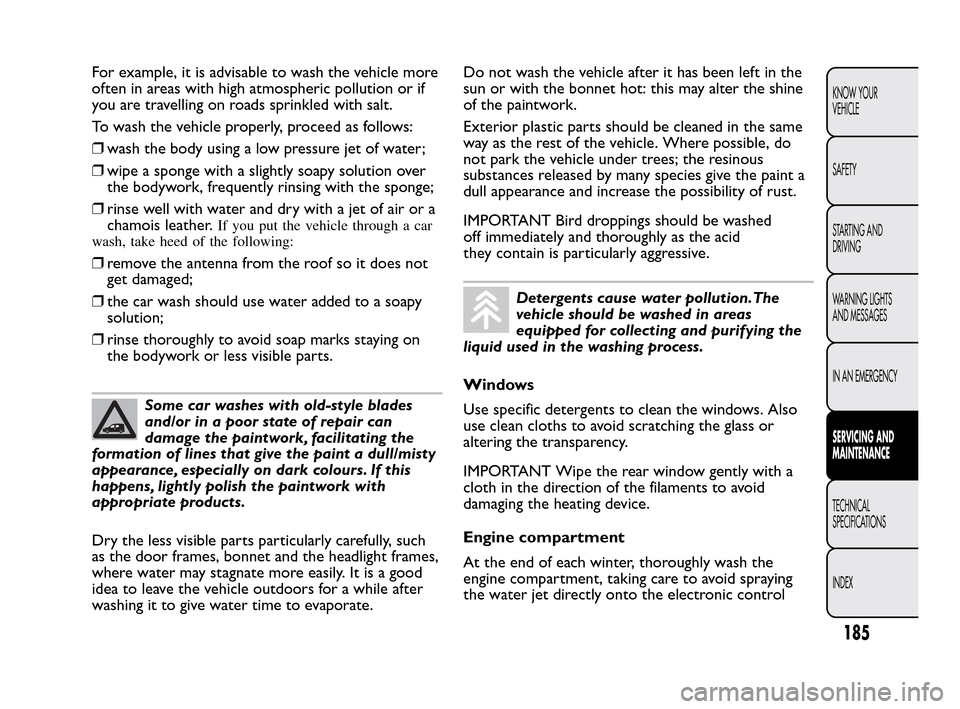
For example, it is advisable to wash the vehicle more
often in areas with high atmospheric pollution or if
you are travelling on roads sprinkled with salt.
To wash the vehicle properly, proceed as follows:
❒wash the body using a low pressure jet of water;
❒wipe a sponge with a slightly soapy solution over
the bodywork, frequently rinsing with the sponge;
❒rinse well with water and dry with a jet of air or a
chamois leather.
If you put the vehicle through a car
wash, take heed of the following:
❒remove the antenna from the roof so it does not
get damaged;
❒the car wash should use water added to a soapy
solution;
❒rinse thoroughly to avoid soap marks staying on
the bodywork or less visible parts.
Some car washes with old-style blades
and/or in a poor state of repair can
damage the paintwork, facilitating the
formation of lines that give the paint a dull/misty
appearance, especially on dark colours. If this
happens, lightly polish the paintwork with
appropriate products.
Dry the less visible parts particularly carefully, such
as the door frames, bonnet and the headlight frames,
where water may stagnate more easily. It is a good
idea to leave the vehicle outdoors for a while after
washing it to give water time to evaporate.Do not wash the vehicle after it has been left in the
sun or with the bonnet hot: this may alter the shine
of the paintwork.
Exterior plastic parts should be cleaned in the same
way as the rest of the vehicle. Where possible, do
not park the vehicle under trees; the resinous
substances released by many species give the paint a
dull appearance and increase the possibility of rust.
IMPORTANT Bird droppings should be washed
off immediately and thoroughly as the acid
they contain is particularly aggressive.
Detergents cause water pollution.The
vehicle should be washed in areas
equipped for collecting and purifying the
liquid used in the washing process.
Windows
Use specific detergents to clean the windows. Also
use clean cloths to avoid scratching the glass or
altering the transparency.
IMPORTANT Wipe the rear window gently with a
cloth in the direction of the filaments to avoid
damaging the heating device.
Engine compartment
At the end of each winter, thoroughly wash the
engine compartment, taking care to avoid spraying
the water jet directly onto the electronic control
185
KNOW YOUR
VEHICLE
SAFETY
STARTING AND
DRIVING
WARNING LIGHTS
AND MESSAGES
IN AN EMERGENCY
SERVICING AND
MAINTENANCE
TECHNICAL
SPECIFICA
TIONS
INDEX